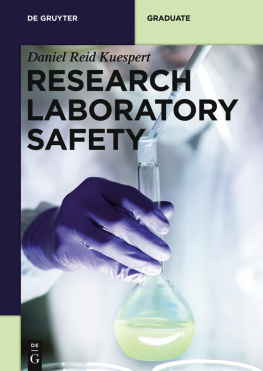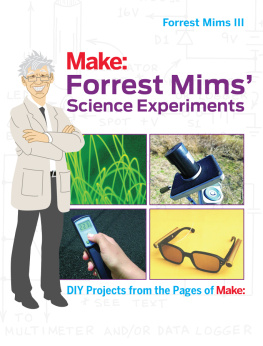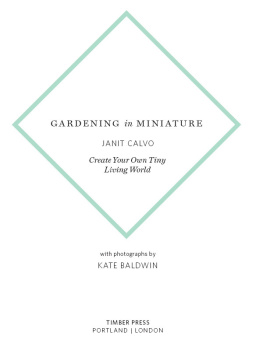
Text and illustrations copyright 2002 by Mark Frauenfelder. All rights reserved. No part of this book may be reproduced in any form without written permission from the publisher.
ISBN 978-1-4521-2653-1
The Library of Congress has cataloged the previous edition as follows:
ISBN 0-8118-3554-5
Designed by Ayako Akazawa
Chronicle Books LLC
680 Second Street
San Francisco, California 94107
www.chroniclebooks.com

Elmers Glue-All is a registered trademark of Borden, Inc. Metamucil is a registered trademark of Procter & Gamble. Slinky is a registered trademark of James Industries.
As with any craft project, it is important that all the instructions are followed carefully, as failure to do so could result in injury. Every effort has been made to present the information in this book in a clear, complete, and accurate manner, however, not every situation can be anticipated and there can be no substitute for common sense. Check product labels, for example, to make sure that the materials you use are safe and nontoxic. Be careful when handling dangerous objects. The authors and Chronicle Books disclaim any and all liability resulting from injuries or damage caused during the production or use of the projects discussed in this book.

IntRoduction
Kia Ora is a tiny island in the South Pacific. To find it on a globe, put your finger on Hawaii and move down so that you are as far south of the equator as Hawaii is north of the equator. Youll be pointing at a country called the Cook Islands. Kia Ora is just one of the Cook Islands hundreds of islands. Its surrounded by sparkling clear water and covered with tall palm trees, lush tropical plants, and clean white sand. Because it is so small (less than the size of a city block) and so remote (the nearest inhabited island is 150 miles away) nobody lives on Kia Ora. At least not anymore. For it has been discovered that a top-secret toy-research laboratory had, until a few years ago, recently occupied Kia Ora.
The laboratory might have remained a secret if it hadnt been for a group of marine biologists from New Zealand who went to Kia Ora to study a peculiar species of sea cucumber that lives in the shallow water off the islands shore. During the expedition, one of the researchers explored the interior of the island and stumbled on a huge crater. It was obvious that the crater had been recently formed because plants hadnt started growing in it yet. The only thing found in the crater was a purple, egg-shaped metal object the size of a washing machine.

The object was taken to the capital of the Cook Islands and presented to the nations king. He called for his royal scientific team to examine the object.
The scientists tried to determine what the egg was made of. They dripped different kinds of acid on it, but the egg did not corrode. They attempted to drill it with a diamond bit, but the egg didnt show a scratch. X-rays revealed nothing. Frustrated, they banged it with a large hammer. The egg made a beautiful bell-like tone, but it didnt show even a dent.
After the scientists gave up, the kings young daughter asked if she could try to open the egg. The scientists all laughed, but the girl climbed on top and sat on it. In a moment, the egg gently swung open, revealing a thick leather-bound book titled Zoober Science Laboratories Notebook.
Apparently, Zoober Labs was a scientific research company that sold its inventions to toy companies around the world. The book turned out to contain a list of recipes and instructions for a variety of materials and projects. It described playful slimes and putties, miniature robots and transport devices, portable power supplies, and wonderfully strange candies. The last experiment in the book was for a working time machine.
The scientists concluded that the time machine experiment must have gone haywire. When the Zoober scientists had activated the time machine, their entire building, its occupants, and everything else within a hundred-foot radius of the time machine was sent hurtling through time; everything, that is, expect for the egg, which apparently was made out of an exotic alloy that resisted the time machines effect.
The lab notebook was written by Zoobers four lead professors: A bald semi-invisible chemist named Philo T. Funsworth, a brilliant girl roboticist named Helena Capek, a genetically modified gorilla geologist named Tambuzi, and Professor Zoober himself, a tiny creature who seems to have come from another solar system. The professors usually referred to themselves simply as the Zoobers.
The book you now hold in your hands contains many of the projects found in the Zoober notebook. Weve selected the ones that you, as a budding mad professor, can easily complete using materials around the house. Some will require assistance from grown-ups; others you can make all by yourself. We did not include the instructions for the time machine, however. While it is surprisingly simple to build and operate the Zoober time machine (we made a working miniature out of items purchased at a convenience store), we feel that in the interest of safety, this experiment is best kept a secret.
Good luck, and have fun!

Lab Rules: Safety Notes and Lab Tips

The scientists at Zoober Labs were almost always concerned about safety. (Its too bad they didnt exercise enough caution with the time machine!) They even hired a consultant, named Safety Kid, who came to the Zoober Labs to teach them how to conduct their experiments with the utmost care. Since you, too, are going to be conducting real scientific experiments with chemicals just like the Zoobers, weve asked Safety Kid to teach you some important rules you must follow to protect yourself and ensure good results.
1. Always get a grown-ups permission before beginning an experiment . Before getting started, show this book to a grown-up and ask him or her to read the instructions for the experiment you want to conduct. Whenever you come across an experiment in the notebook with Safety Kids picture, that means you need to be extra careful, because something hot, sharp, or potentially dangerous in some other way will be involved in the experiment. That means an adult needs to stick around while youre doing it.
2. Read the experiment all the way through before starting . That way, youll know what you need and how long it is going to take to complete the experiment.
3. Wear safety glasses . If you think wearing goggles is for dweebs, think again. Not only do goggles protect your eyes, they make you look like a scientist, which is what you are when you conduct an experiment. While none of the chemicals and materials used here are especially toxic or dangerous, they could irritate your eyes. You can pick up an inexpensive pair of clear plastic goggles at a hardware store.
Next page













